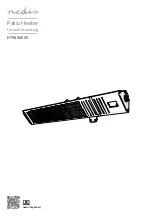
LP-314 Rev. 012 Rel. 003 Date 9.27.19
34
Part 8 - Gas Connections
Failure to follow all precautions could result in fire, explosion, severe
injury, or death.
Ensure the gas on which the appliance will operate is the same type
specified on the rating plate. Failure to do so could result in appliance
malfunction, property damage, personal injury, or death.
The gas supply shall have a minimum of no less than 3.5” water column,
a maximum inlet pressure of no greater than 14” water column (350
mm), and ½ pound pressure (3.5 kPa). The entire piping system, gas
meter, and regulator must be sized properly to prevent excessive
pressure drop (greater than 0.5” WC) as stated in the National Fuel Gas
Code. This information is listed on the rating plate.
It is very important that the appliance is connected to the gas type
noted on the rating plate: “LP” for liquefied petroleum, propane gas, or
“Nat” for natural or city gas. All gas connections must be approved by
the local gas supplier or utility, in addition to the governing authority,
prior to turning the gas supply on.
Do not remove the adaptor in Figure 25! It is mandatory that this fitting
is used for connection to a field fabricated drip leg per the National Fuel
Gas Code. You must ensure that the entire gas line to the connection at
the appliance is no smaller than 3/4”.
If the appliance experiences a pressure drop greater than 1” WC, the
meter, regulator, or gas line is undersized or in need of service. A
manometer can be attached to the incoming gas drip leg by removing
the cap. The gas pressure must remain between 3.5” and 14” WC during
stand-by (static) mode and while in operating (dynamic) mode at full
output.
If an in-line regulator is used, it must be installed a minimum of 10 feet
from the heater. It is very important that the gas line is properly purged
by the gas supplier or utility. Improper line sizing or failure to properly
purge the lines will result in ignition failure. This problem is especially
noticeable in NEW LP installations, in empty tank situations, or when a
UL recognized fuel gas detectors are recommended in all enclosed
propane and natural gas applications where there is a potential for
an explosive mixture of fuel gas to accumulate. The installation of
these detectors should be made in accordance with the detector
manufacturer’s recommendations, and/or local laws. Failure to
install fuel gas detectors in these applications could result in fire,
explosion, property damage, severe personal injury, or death.
A. Gas Pipe Sizing Tables
1. Gas Pipe Sizing
This information is for reference use only. Refer to gas pipe
manufacturer specifications for actual delivery capacity. The DOE
standard for Natural Gas is 1100 BTU/ft
3
. Contact the local gas
supplier for actual BTU/ft
3
rating.
2. Natural Gas Pipe Sizing
The following table lists maximum capacity of pipe in cubic feet of
gas per hour for gas pressures of 14” or less and a pressure drop of
0.5 inches water column, based on a 0.60 specific gravity for natural
gas.
Pipe Size (in.)
Length of Pipe (Feet)
BTU’s Per
Hour x 1,000
Schedule 40
Metallic Pipe
(0.60 Specific
Gravity,
0.5 WC
Pressure Drop)
10
20
30
40
50
60
80
100
150
200
3/4
360
247
199
170
151
137
1
678
466
374
320
284
257
220
195
157
134
1 1/4
1390
957
768
657
583
528
452
400
322
275
1 1/2
2090
1430
1150
985
873
791
677
600
482
412
2
4020
2760
2220
1900
1680
1520
1300
1160
928
794
3
11300
7780
6250
5350
4740
4290
3670
3260
2610
2240
4
23100
15900
12700
10900
9660
8760
7490
6640
5330
4560
Table 11 - Natural Gas Delivery Capacity - Refer to ANSI Z223.1 - National Fuel Gas Code, Latest Edition
LP-179-Q
03/15/12
THIS ADAPTER
UNION
GAS LINE
DO NOT REMOVE
DRIP
LEG
Figure 25 - Gas Connection
utility company shuts off service to an area to maintain supply lines.
Once all inspections have been performed, the piping must be leak
tested. If the leak test requirement is a higher test pressure than the
maximum gas inlet pressure, isolate the heater from the gas line
to continue leak testing. To do this, turn off the factory and field-
installed gas cocks. Failure to do so may damage the gas valve.
In the event the gas valve is exposed to a pressure greater than
½ PSI, 14” water column, the gas valve must be replaced. The gas
valve must not be replaced with a conventional gas valve under any
circumstances. As an additional safety feature, the gas valve in this
appliance has a flanged connection to the swirl plate and blower.
















































